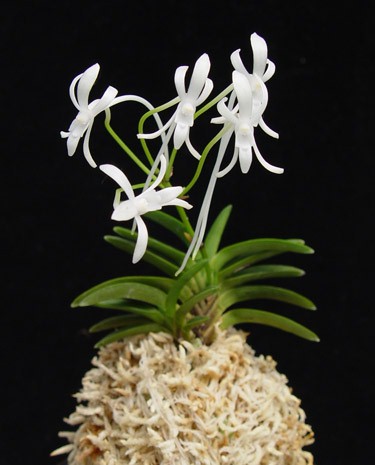
Neofinetia falcata is the first orchid ever to be grown as a house plant in Japan in the 1600’s. It is also known as the Samurai Orchid, as Shogun Tokugawa Ienari fell in love with the plant in the late 1800's. It is rumored that samurai would help in searching and collecting the plants from the mountains. It is one of the world’s highest priced orchid, with a history of some varieties selling for over $100,000! Today, there are a wide variety of prices thanks to this popular, collectible orchid's commercial cultivation.
Neofinetia are enjoyed as bonsai are, for the foliage and the overall presentation of the plant. In Japan, it is said that the key to growing them is to enjoy the plant, not only for the flowers, but every day of the year. They generally flower in summer, and have a very sweet fragrance reminiscent of Jasmine or Indian Gardenia. This fragrance is typically strongest at dusk and dawn.
All in all, the Neofinetia falcata is an easy plant to cultivate and flower, and makes for a great addition to any orchid collection. Who knows – you may end up joining the Neo community as an avid collector yourself!
Temperature and Humidity
Neofinetia are very resilient plants, making them quite easy to grow. They enjoy semi-shaded light conditions and can tolerate temperatures from 32°F to 100°F (0°C to 38°C). Ideal temperatures would be daytime temperatures around 75°F (24°C), nighttime temperatures around 60°F (16°C). To grow Neofinetia to their full potential, grow them outdoors in a semi-shaded area with bright morning sun. Be careful not to have these outside when the weather is below 50°F and rainy, as cold and wet conditions easily lead to bacterial or fungal rot. From October through April, place your Neofinetia in an area that gets as cool as 40°F (the 50’s would be ideal). Neofinetia benefit from humidity levels of 50% to 70%. This can be achieved at home with the use of a humidifier or a humidity tray. Just make sure that the plant is not standing in water or the roots will rot.
Watering
During the growing season from May through September, Neofinetia like to be kept fairly moist, with the media becoming only slightly damp between watering. If you allow the media to dry out completely during this period, your plant may abort flowering for the season. During the cool season, water only so much as to keep the media from becoming "bone dry". The main focus during winter is to provide the plants with a dormant rest while avoiding prolonged wet conditions around the roots.
When repotting your Neofinetia during the active growing season, do not water the media for at least 4 days. This allows cuts and breaks in the roots to callous and avoid rotting upon being watered.
We always recommend watering in the morning, as this gives the leaves time to dry and avoid bacterial growth overnight. If possible, use water low in alkalinity, such as rainwater, distilled water, or reverse osmosis water. If you have a dehumidifier in your home, the water that collects in the tray is excellent for watering orchids.
Feeding
We highly recommend Green Jungle Orchid Food, specially formulated to provide orchids with the nutrients they would naturally encounter in their wild habitats. This is the fertilizer that we developed to use on our own plants in production, with excellent results for decades! This formula works best with water low in alkalinity (such as rainwater, distilled water, or reverse osmosis water). However, you may use tap water, keeping in mind that mineral buildup will require repotting more frequently, on the order of every 1 to 2 years.
If potting in bark mix, fertilize every time you water during the summer growing season, flushing with non-softened water once a month. This rinses the media of salt and mineral buildup. If potting in sphagnum moss, fertilize every 3rd watering during the growing season. Stop feeding in September to introduce your Neofinetia into its winter rest. This is essential to avoid rot, as well as for a successful flowering event the following summer.
Potting
We recommend growing Neofinetia in several ways. The traditional method is in a Japanese-style moss mound, using high grade (3A or better) New Zealand sphagnum moss in a Fuuran pot. The high mount and perforated pot provide moisture to the roots while maintaining high airflow to avoid rotting. To create the sphagnum mound, long fiber sphagnum moss works best. We often use 5A New Zealand sphagnum moss (+12 inches in length) for the outer layer, and standard New Zealand sphagnum moss for the inside of the mound. Alternatively, Neofinetia can also be grown bare root in baskets (like Vandas if the humidity levels are high) and mounted on cork slabs. Neofinetia should be repotted once per year in March, just as they are coming out of their winter dormancy.
All of our Neofinetia orchids come standard in our Premium Neofinetia Orchid Bark Mix. However, we do offer a Moss-mound Upgrade to have the Neofinetia you are ordering upgraded to a traditional moss mound by one of our talented greenhouse staff.
Pest Control
While Neofinetia are highly resilient to pests and disease, they can attract scale. The best treatment for scale is often a systemic pesticide.
